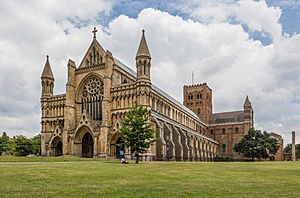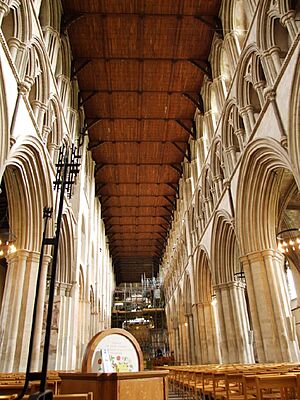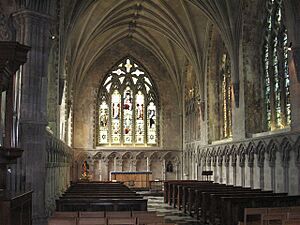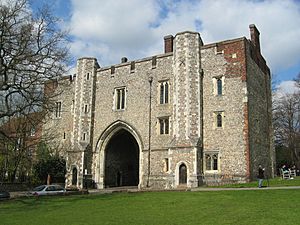St Albans Cathedral facts for kids
Quick facts for kids Cathedral and Abbey Church of St Alban |
|
|---|---|

St Albans Abbey viewed from the south west
|
|
| Lua error in Module:Location_map at line 420: attempt to index field 'wikibase' (a nil value). | |
| Location | St Albans, Hertfordshire |
| Country | United Kingdom |
| Denomination | Church of England |
| Website | stalbanscathedral.org |
| Architecture | |
| Style | Norman/Romanesque/Gothic |
| Years built | 1077–1893 |
| Specifications | |
| Length | 167.8 metres (551 ft) |
| Nave length | 85 metres (279 ft) |
| Nave width | 23 metres (75 ft) |
| Width across transepts | 58.5 metres (192 ft) |
| Height | 43.9 metres (144 ft) |
| Nave height | 20.2 metres (66 ft) |
| Number of towers | 1 |
| Tower height | 43.9 metres (144 ft) |
| Bells | 12 (2010) |
| Tenor bell weight | 21-0-19 (1075kg) |
| Administration | |
| Diocese | St Albans (since 1877) |
| Province | Canterbury |

St Albans Cathedral is a large Anglican church in St Albans, Hertfordshire, England. It used to be known as St Albans Abbey. Its main hall, called the nave, is the longest of any cathedral in England, measuring about 84 metres (276 ft).
Much of the cathedral's design comes from the Norman period. It officially became a cathedral in 1877. Many local people still call it "the Abbey." This is because the cathedral building was once the church of an old Benedictine monastery.
Even though it's a cathedral, it also works as a local parish church. The person in charge, called the Dean, acts like the main priest (or rector) for the local community.
Contents
History of St Albans Cathedral
Britain's First Christian Martyr
The story of St Albans Cathedral begins with Alban. He lived in the Roman city of Verulamium, which is now St Albans, in Hertfordshire, England. This was around 22 miles (35 km) north of London.
Long ago, before Christianity was widely accepted, Christians were treated badly by the Romans. Alban, who was not a Christian at the time, bravely hid a Christian priest named Amphibalus in his home. During this time, Alban learned about Christianity and decided to become a Christian himself.
When Roman soldiers came looking for the priest, Alban swapped clothes with Amphibalus. He let himself be arrested instead. Alban was brought before a judge. He openly declared his new Christian faith and was sentenced to death. Legend says he was beheaded right where the cathedral stands today.
Historians are not completely sure when Alban was executed. Some suggest it was around 250 AD, while others think it might have been 209, 254, or 304 AD. The tomb of St Amphibalus is also inside the cathedral.
Building the Norman Abbey
Most of the cathedral's current shape and size come from the time of the first Norman abbot, Paul of Caen. He was in charge from 1077 to 1093. He was appointed by the new Archbishop of Canterbury, Lanfranc.
The abbey was built in a cruciform (cross-shaped) design. It was the largest church built in England at that time. Robert the Mason, a Norman builder, made sure the foundations were very strong. He used a continuous wall of layered bricks, flints, and mortar. The foundations went down twelve feet to reach solid rock. Extra large stones were used under the central tower.
The tower was a great success. It is the only large central tower from the 11th century still standing in England. Robert built it with thick supporting walls and four huge brick pillars. The tower has four levels, getting narrower at each stage. It weighs 5,000 tons and is 43.9 metres (144 ft) high. The original roof was probably pyramid-shaped, but today it is flat.
The monastery was finished in 1089. However, it was not officially blessed until December 28, 1115. King Henry I and many important bishops and nobles attended the ceremony.
A nunnery (Sopwell Priory) for nuns was also built nearby in 1140.
In the cathedral today, you can still see the original Norman arches under the central tower and on the north side of the nave. The other arches in the building are Gothic. These were added during rebuilding and extensions in the Middle Ages. Some parts were also restored in the Victorian era.
The abbey was made bigger in the 1190s by Abbot John de Cella. The plain Norman west front was rebuilt by Hugh de Goldclif. This work was very expensive. However, most of it has been lost due to weather and later changes.
The St Albans Psalter (made around 1130–45) is a famous example of Romanesque illuminated manuscripts. These were beautiful handwritten books with colorful pictures, made at the Abbey. Later, Matthew Paris, a monk at St Albans, was a famous writer and artist. He lived from 1217 to 1259. His surviving manuscripts are very important for historians.
Nicholas Breakspear was born near St Albans. He went to school there and tried to join the abbey, but he was not accepted. He later joined an abbey in France. In 1154, he became Pope Adrian IV. He is the only English Pope in history. In the same year, the head of St Albans Abbey was confirmed as the most important abbot in England.
Images for kids
-
Remains of the cathedral's cloisters.
-
St Albans Abbey in its prime before its dissolution. Painting by Jo Freeman dated 1977
-
Ruins of Richard Lee's house at Sopwell Priory
-
The Wallingford Screen of c. 1480 — the statues are Victorian replacements (1884–89) of the originals, destroyed in the Dissolution of the Monasteries, when the screen itself was also damaged. Statues of St Alban and St Amphibalus stand on either side of the altar.
-
Initial at the start of the "Our Father"
-
Christ in the house of Simon the Pharisee, with Mary Magdalene washing his feet, Luke 7:36-50
See also
 In Spanish: Catedral de St Albans para niños
In Spanish: Catedral de St Albans para niños




















